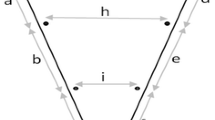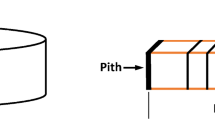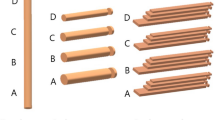Abstract
Key message
High levels of percentage green veneer recovery can be obtained from temperate eucalypt plantations. Recovery traits are affected by site and log position in the stem. Of the post-felling log traits studied, out-of-roundness was the best predictor of green recovery.
Context
Eucalyptus globulus and Eucalyptus nitens are widely planted in temperate regions of the globe but few studies of rotary peeling have been documented.
Aims
This study aims to examine differences among sites and log positions in post-felling log traits and green veneer recovery traits and determine the extent to which log traits explain variation in recovery traits.
Methods
Log traits and green rotary-peeled veneer recovery traits from six temperate eucalypt plantations were studied. Selected plantations encompassed different age, site productivity, silvicultural and species classes in south-eastern Australia. Differences in log and recovery traits among sites and between lower and upper logs were examined, as was the extent to which log traits explained variation in recovery traits.
Results
Differences among sites for percentage recovered green veneer were non-significant, despite significant differences for peelable billet volume, roundup loss, residual core diameter and all post-felling log traits: small end diameter, sweep, taper, out-of-roundness, end splitting and dynamic modulus of elasticity (MOEdyn). The lower log exhibited more sweep, taper and out-of-roundness but lower MOEdyn and less recovered green veneer. Out-of-roundness was the best predictor of recovery traits (R 2 = 13–21 %, P < 0.001).
Conclusion
Recovered green veneer was high across all sites and log positions (78 % overall).


Similar content being viewed by others
References
Arnold RJ, Xie YJ, Midgley SJ, Luo JZ, Chen XF (2013) Emergence and rise of eucalypt veneer production in China. Int For Rev 15:33–47
Beadle C, Medhurst J, Forrester D (2011) Linking silvicultural management to solid-wood values. In: Walker J (ed) Developing a eucalypt resource: learning from Australia and elsewhere. Wood Technology Research Centre, University of Canterbury, Christchurch, pp 77–92
Blackburn D, Farrell R, Hamilton M, Volker P, Harwood C, Williams D, Potts B (2012) Genetic improvement for pulpwood and peeled veneer in Eucalyptus nitens. Can J For Res 42:1724–1732
Blackburn DP, Hamilton MG, Harwood CE, Baker TG, Potts BM (2013) Assessing genetic variation to improve stem straightness in Eucalyptus globulus. Ann For 70:461–470
Blakemore P, Morrow A, Washusen R, Harwood C, Wood M, Ngo D (2010) Evaluation of thin-section quarter-sawn boards and rotary veneer from plantation-grown Eucalyptus nitens. vol Technical Report 202. Cooperative Research Centre for Forestry, Hobart
Brancheriau L, Bailleres H (2002) Natural vibration analysis of clear wooden beams: a theoretical review. Wood Sci Technol 36:347–365. doi:10.1007/s00226-002-0143-7
Downes G, Worledge D, Schimleck L, Harwood C, French J, Beadle C (2006) The effect of growth rate and irrigation on the basic density and kraft pulp yield of Eucalyptus globulus and E. nitens. N Z J For Sci 57:13–22
Farrell R, Blum S, Williams D, Blackburn D (2011) The potential to recover higher value veneer products from fibre managed plantation eucalypts and roaden market opportunities for this resource: part A. Forest & Wood Products Australia, Melbourne
Kibblewhite RP, Johnson BI, Shelbourne CJA (2000) Kraft pulp qualities of Eucalyptus nitens, E. globulus, and E. maidenii, at ages 8 and 11 years. N Z J For Sci 30:447–457
Kubler H (1988) Silvicultural control of mechanical stresses in trees. Can J For Res 18:1215–1225
Luo JZ, Arnold R, Ren SQ, Jiang Y, Lu WH, Peng Y, Xie YJ (2013) Veneer grades, recoveries, and values from 5-year-old eucalypt clones. Ann For Sci 70:417–428. doi:10.1007/s13595-013-0268-x
McGavin RL, Bailleres H, Lane F, Blackburn D, Vega M, Ozarska B (2014) Veneer recovery analysis of plantation eucalypt species using spindleless lathe technology. Bioresources 9:613–627
McKinley RB, Shelbourne CJA, Low CB, Penellum B, Kimberley MO (2002) Wood properties of young Eucalyptus nitens, E. globulus, and E. maidenii in Northland, New Zealand. N Z J For Sci 32:334–356
Medhurst J, Downes G, Ottenschlaeger M, Harwood C, Evans R, Beadle C (2012) Intra-specific competition and the radial development of wood density, microfibril angle and modulus of elasticity in plantation-grown Eucalyptus nitens. Trees Struct Funct 26:1771–1780. doi:10.1007/s00468-012-0746-z
Mohammed C, Battaglia M, Wardlaw T, Smith A, Pinkard E, Glen M, Tommerup I, Potts B, Vaillancourt R (2003) Mycosphaerella leaf diseases of temperate eucalypts around the southern pacific rim. N Z J For Sci 33:362–372
Okuyama T, Doldan J, Yamamoto H, Ona T (2004) Heart splitting at crosscutting of eucalypt logs. J Wood Sci 50:1–6. doi:10.1007/s10086-003-0533-y
Pinkard EA, Mohammed C, Beadle CL, Hall MR, Worledge D, Mollon A (2004) Growth responses, physiology and decay associated with pruning plantation-grown Eucalyptus globulus Labill. and E. nitens (Deane and Maiden) Maiden. For Ecol Manag 200:263–277
Potts B, Hamilton M, Blackburn D (2011) Genetics of eucalypts: traps and opportunities. In: Walker J (ed) Developing a eucalypt resource: learning from Australia and elsewhere. Wood Technology Research Centre, University of Canterbury, Christchurch, pp 1–26
Shi S, Walker J (2006) Wood-based composites: plywood and veneer-based products. In: Walker JCF (ed) Primary wood processing: principles and practice, 2nd edn. Springer, Dordrecht, pp 391–426
Thomas D, Joe B, Austin S, Henson M (2009) Characterisation of plywood properties manufactured from plantation grown eucalypts. Forest & Wood Products Australia, Melbourne
Wardlaw T (2011) A climate analysis of the current and potential future Eucalyptus nitens and E. globulus plantation estate on Tasmanian State forest. Tasforests 19:17–27
Warensjo M, Rune W (2004) Stem straightness and compression wood in a 22-year-old stand of container-grown Scots pine trees. Silva Fenn 38:143–153
Washusen R (2011) Processing plantation grown Eucalyptus globulus and Eucalyptus nitens for solid wood products—is it viable? Cooperative Research Centre for Forestry, Hobart
Washusen R, Harwood C, Morrow A, Northway R, Valencia JC, Volker P, Wood M, Farrell R (2009) Pruned plantation-grown Eucalyptus nitens: effect of thinning and conventional processing practices on sawn board quality and recovery. N Z J For Sci 39:39–55
Wolfinger R, Chang M (1995) Comparing the SAS GLM and MIXED procedures for repeated measures. In: Proceedings of the Twentieth Annual SAS Users Group Conference, Cary, NC. SAS Institute Inc
Wood MJ, McLarin ML, Volker PW, Syme M (2009) Management of eucalypt plantations for profitable sawlog production in Tasmania, Australia. Tasforests 18:117–130
Yang JL (2005) The impact of log-end splits and spring on sawn recovery of 32-year-old plantation Eucalyptus globulus Labill. Holz Roh Werkst 63:442–448. doi:10.1007/s00107-005-0035-2
Acknowledgments
We acknowledge Forestry Tasmania (FT), Australian Bluegum Plantations (ABP), New Forests, PF Olsen and David Swann for the assistance in project planning, access to sites, the provision of trees and staff, tree felling, and log transport; Island Specialty Timbers (IST) and ABP for use of their log yards, and log handling; and Austral Plywoods for peeling large-diameter logs. Specifically, we thank Mark Hunt (NCFFI and UTAS), Chris Emmett (IST), Peter Wass, Crispen Marunda, Kristen Dransfield, Matt McCormic, Mitchell Fulford, Paul Adams, Rowan Eiszele, Shane Burgess (FT), Phil Mason and Christian Hong-Tan (New Forests), Stephen Rymer and Noel Bull (PF Olsen), Nigel Miller and Paddy Noonan (Forestech Management), Mark Diedrichs, Alan Rossouw, Simon Malseed (ABP), Chris Harwood (CSIRO), Rowan Reid and staff at the Queensland Department of Agriculture, Fisheries and Forestry Salisbury Research Centre for their technical and/or professional assistance.
Funding
We thank the National Centre for Future Forest Industries (NCFFI) for funding.
Author information
Authors and Affiliations
Corresponding author
Additional information
Handling Editor: Jean-Michel Leban
Contribution of the co-authors
All authors undertook writing/editing the manuscript and all, except Brad Potts, were involved in data collection. Matthew Hamilton oversaw the selection, felling and transport of logs, undertook statistical analyses and wrote the first draft of the manuscript. Robert McGavin and Henri Bailleres oversaw the peeling of logs.
Electronic supplementary material
Below is the link to the electronic supplementary material.
ESM 1
(DOCX 33.3 kb)
Rights and permissions
About this article
Cite this article
Hamilton, M.G., Blackburn, D.P., McGavin, R.L. et al. Factors affecting log traits and green rotary-peeled veneer recovery from temperate eucalypt plantations. Annals of Forest Science 72, 357–365 (2015). https://doi.org/10.1007/s13595-014-0430-0
Received:
Accepted:
Published:
Issue Date:
DOI: https://doi.org/10.1007/s13595-014-0430-0




